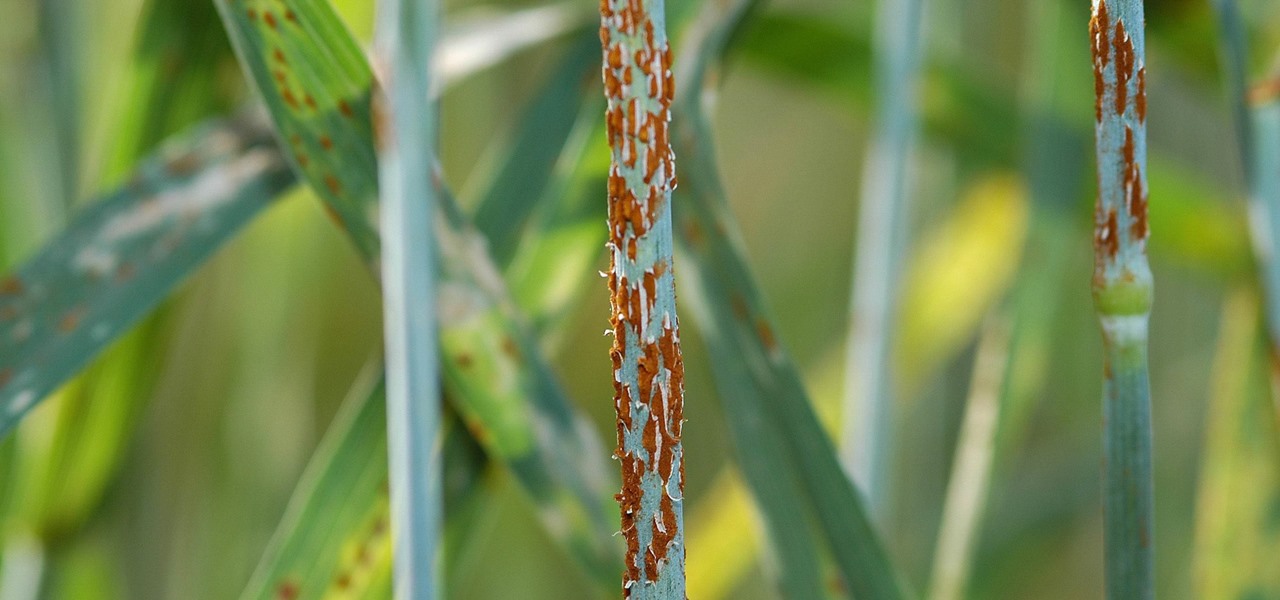We may not fully appreciate all the important roles wheat plays in our lives until it's gone—or at least, when it's in very short supply. What would a world be like without bread, cakes, cereal, pasta, or wheat beer? If the dire warnings about an impending stem rust fungus come to pass, we may know all too soon.
When a massive wheat stem rust infection broke out in Sicily between April and June 2016, farmers and scientists immediately became worried that spores would spread the infection to other areas and ruin the next growing season.
The stem rust fungus attacks the wheat stems, growing their spores into a rust-colored fungus that kills the plants. Once the Sicilian outbreak was over, tens of thousands of hectares—100 acre areas—of wheat crops were destroyed, representing about 1% of the approximate 1.2 million hectares planted with durum wheat in Italy with an estimated value of €5-10 million (roughly $5.2-10.5 million).

Researchers took samples from the outbreak and sent them to the Global Rust Reference Centre (GRRC) at Aarhus University in Denmark to determine what "race" of the fungus infected the wheat. Wheat stem rust is caused by a host-specific—wheat, specifically—type of fungus called Puccinia graminis f. sp. tritici, and the type is further subdivided into races based on infection potency.
It was found that the Sicily outbreak was caused by a highly virulent variant of race TTTTF. Europe hasn't seen outbreaks of wheat stem rust since the 1950s, so the size of the Sicilian epidemic and the virulence of the race TTTTF could mean the infection is back with a vengeance.
Both bread wheat and durum wheat are grown in Italy, but durum—used to make pasta—is the main wheat crop. Durum has proven resistant to many stem rust fungus outbreaks and carries Sr31 and Sr9e genes that allow it to beat back the fungus, though, even these hardy strains are no match for race TTTTF.
Just as concerning is the discovery that two new strains of yellow rust—another fungal wheat disease—have infected large areas in Europe, North Africa, East Africa, and Central Asia for the first time. The yellow rust fungus diseases haven't been fully characterized yet, but they seem to be closely related to potent strains that have caused outbreaks in North American and Afghanistan.
How Outbreaks Steal Our Bread
Since the area infected in Sicily in 2016 was huge, a huge number of spores were produced by the fungus on the wheat plants—spores easily dispersed, carried on the wind, and even durable enough to withstand mild winters—ready to infect more plants. Scientists fear that spores released during the Sicilian outbreak may have traveled throughout the Mediterranean region.

Scientists at Cambridge University and the UK Met Office used advanced, wind-borne spore dispersal models to scientifically speculate where the Sicilian spores were likely to land. Their model predicted southern Italy to have the highest risk for wheat stem rust infection, with slight probability of outbreaks in western Greece, Albania, Montenegro, Bosnia and Herzegovina, Croatia, Slovenia, northern Libya, and northeast Tunisia.
Spores aren't the only factor needed to promote growth of the wheat stem rust fungus. Water that collects on the wheat stem surface from rain or heavy dews, along with warm temperatures, are the ideal conditions for growth of the fungus. Stem rust is a warm-temperature disease that grows best between 65-85°F, but the fungus can grow at temperatures between 59-104°F.
Farmers won't know if the spores survived the winter until rust starts to appear on their wheat crops, so time is going to be the critical element.
The GRRC and the International Maize and Wheat Improvement Center in Texcoco, Mexico, as well as the Food and Agriculture Organization of the United Nations in Rome, issued alerts about the wheat stem rust and the two yellow rust diseases on February 3, 2017.
Scientists believe by raising an alert now, before the European wheat crops start to grow, farmers may have enough time to monitor for the rust and apply fungicides as early as infection appears. And time may give plant researchers time to breed resistant wheat varieties.
"We have to be careful of shouting wolf too loudly. But this could be the largest outbreak that we have had in Europe for many, many years," said Chris Gilligan, an epidemiologist at the University of Cambridge, UK, and leader of the team that created the spore spread models in a Nature report this month.
The fate of some of Europe's wheat crops may be at the mercy of time, and literally hanging in the wind.
Just updated your iPhone? You'll find new emoji, enhanced security, podcast transcripts, Apple Cash virtual numbers, and other useful features. There are even new additions hidden within Safari. Find out what's new and changed on your iPhone with the iOS 17.4 update.



























Be the First to Comment
Share Your Thoughts